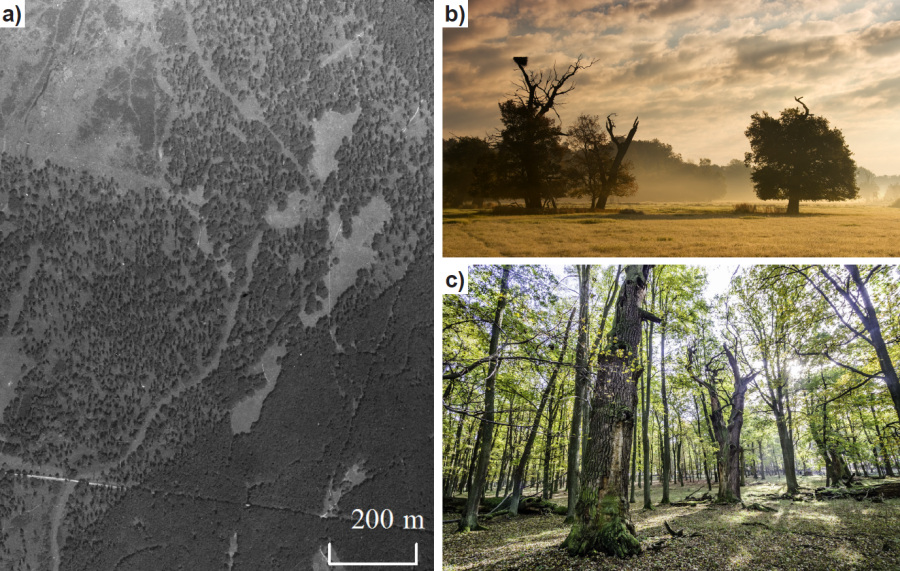Extinction debt in Moravian Amazon proved
Interesting results often emerge when scientists from different fields start to cooperate. This has also been proved by the research of the influence of landscape history on the occurrence of old trees and specially protected beetles, which connects geographic and biological data and has just been published in a prestigious ecological journal.
The study dealing with the territory of floodplain forests along the lower reaches of the Dyje and Morava Rivers and their confluence, nicknamed Moravian Amazon, has been conducted by Dr. Jan Miklín from the Department of Physical Geography and Geoecology of the Faculty of Science, University of Ostrava and biologists from the Institute of Entomology, Biology Centre of the Czech Academy of Sciences. In their research, they put together data from vast mapping of old and solitary trees and the data of landscape evolution in the last century.
“From a database of almost twelve thousand trees mapped in the past years, mainly old and big oaks were selected, as well as the trees containing endangered and protected beetle species such as great capricorn beetle or hermit beetle,” says Jan Miklín. “Each tree was then assigned with the information of the type of forest (according to the canopy cover) it grows in now and the type of forest it grew in 1938.” The data were obtained from old aerial images, based on which different levels of forest canopy were studied – from dense forests to solitary trees on meadows. Making statistical analyses, the authors then focused on answering the questions of what effect the present forest type has on the occurrence of beetles and old trees, what role the forest state plays at the beginning of the 20th century, and what relation there is between the forest health and the forest type.
Thin forests used to be common in the past, either as a result of natural disturbances or later due to forest management practices. At the beginning of the 19th century, they however started to disappear, along with the species related to their conditions. In recent years, thin forests have represented a hot topic in contemporary conservation ecology as open-canopy forests can be described and Central European ‘biodiversity hotspots’ and, at the same time, some of the most endangered and disappearing ecosystems.
Heritage of the past
The fact that old trees and trees occupied by the studied species rather prevail in open-canopy forest is not that surprising; it can be derived from ecological demands of the studied beetles. Yet, it also proves that the very remnants of open-canopy cover – groups of solitary oaks on meadows – belong to the most valuable biotopes in the Moravian Amazon.
Another important fact is that old trees growing presently in closed-canopy forests can more often be found where there were open-canopy forests in 1938 and it is also true for the beetles. “The more open the forest was in 1938, the more trees occupied by protected species can be found there nowadays.” The results of the study published in the prestigious Diversity and Distributions journal (Impact Factor 4.4, rank 7/53 in the discipline of Biodiversity Conservation) thus demonstrate the so-called extinction debt or the state in which organisms persist for some time in the environment that is no longer suitable for their future existence; in other words, they are likely to become extinct.
Data on the health of trees also show that if growing in closed-canopy forests, trees die much faster than if growing in open-canopy forests. Transformations of forest landscapes in the past centuries due to changes in forest management therefore directly participated in the destruction of biological diversity.
“This study makes it possible to realise that landscape management practices have measurable consequences even centuries later. If we want to save endangered species, what needs to be done is to start acting and introduce proper conservation and management measures into the territory. And this is exactly what our study should help to do,” concludes Dr. Miklín.
Over the last decades, Moravian Amazon has been endangered by practically total absence of large-scale nature conservation and intensive timber harvesting due to which old cover has been disappearing at an unprecedented rate in the context of the past one hundred years. Endangered species and solitary oaks, symbols of the local landscape, are mere relics of former times and nothing is done for their maintenance or, even better, for the re-establishment of biologically valuable biotopes of open-canopy forests.

Figure description: Relatively large areas of open-canopy forests were characteristic of Moravian Amazon at the beginning of the 20th century (a). Nowadays, old oaks – veterans – grow on meadows (b), but also in closed-canopy forests (c) in the places where there used to be open-canopy forests in the past.
Updated: 04. 01. 2018



















